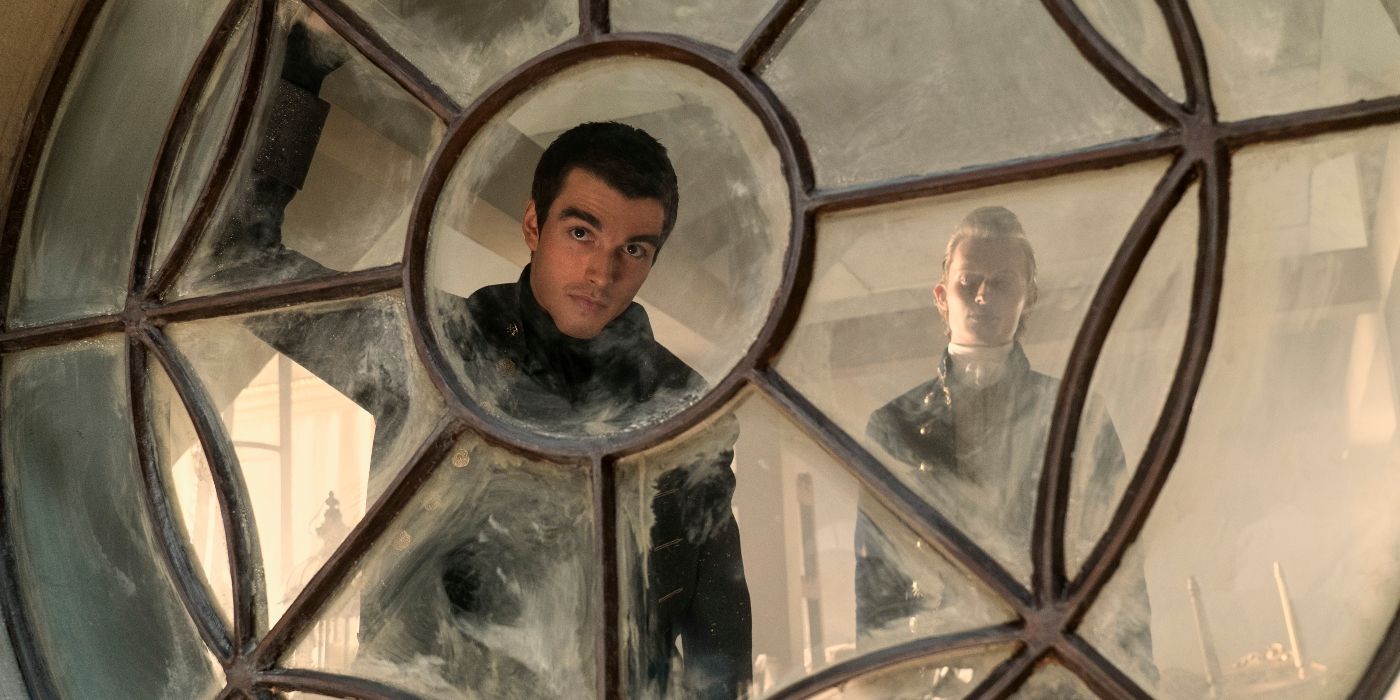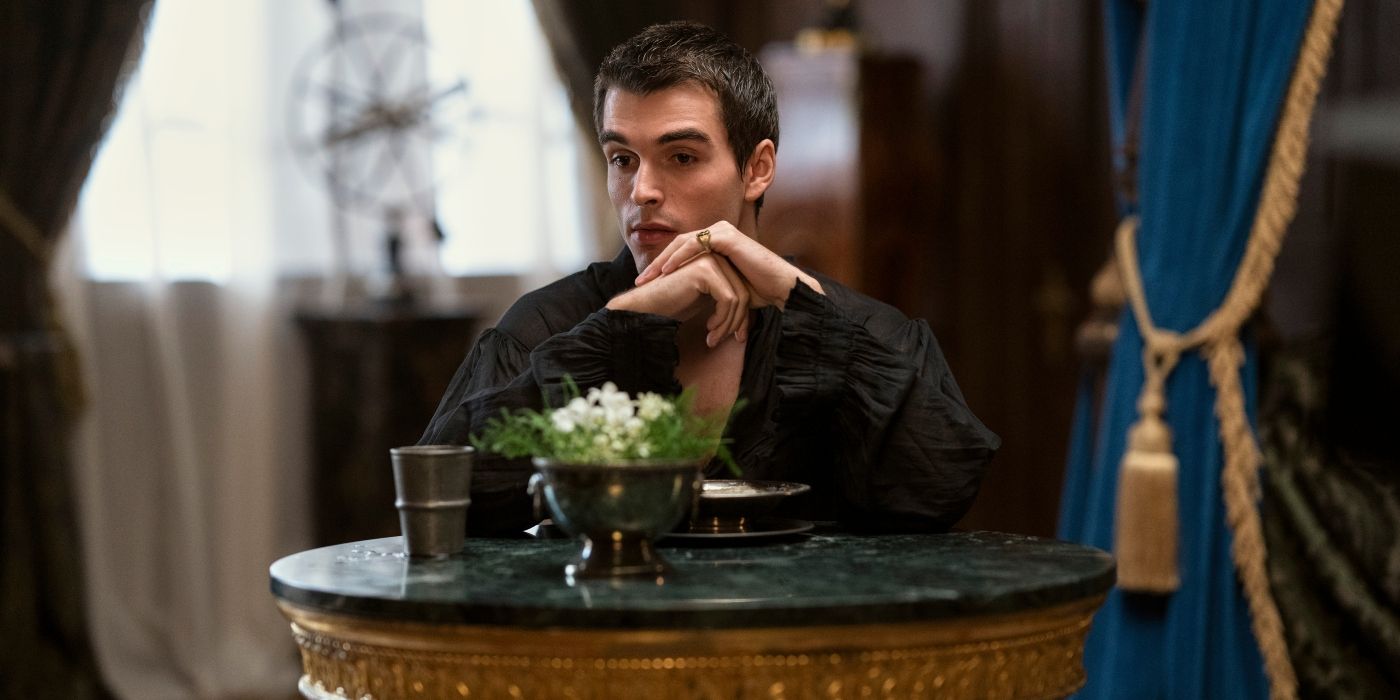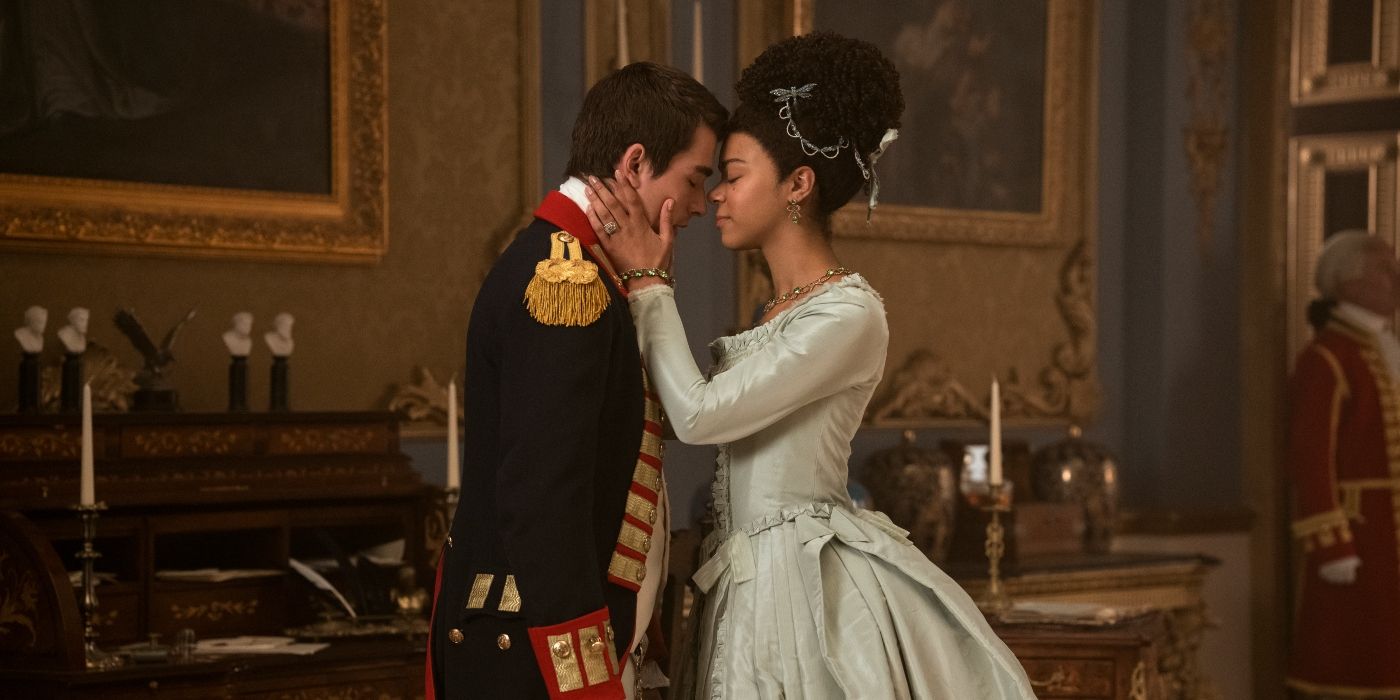Editor’s observe: The beneath comprises spoilers for Queen Charlotte: A Bridgerton Story.Episode 4 of Queen Charlotte: A Bridgerton Story is a really stunning, heartbreaking factor to behold — and positively one thing followers weren’t anticipating to see popping out of the Bridgerton universe. In any case, the unique present primarily based on the collection of books by Julia Quinn is often stuffed solely with light-hearted romance. Nobody would ever be capable of predict that its first spin-off would characteristic a complete hour of its romantic lead being tortured to exhaustion by a half-sadistic, half-well-intentioned doctor. The romantic lead in query is none aside from the titular queen’s (India Amarteifio) husband, King George III (Corey Mylchreest). The explanation for his struggling? His bouts of hallucination and disorganized speech outcome from a mysterious, poorly comprehended psychological sickness.
Effectively, possibly we should always’ve seen it coming. Tales about “mad King George” have been making the rounds in historical past and story books alike ever because the 18th century. The monarch’s psychological instability has been the theme of many movies and TV collection in regards to the British Regency interval, essentially the most well-known of which is certainly Nicholas Hytner‘s 1994 film The Insanity of King George, wherein Nigel Hawthorne performs a George III suffering from episodes of delusion and paranoia. Bridgerton itself had already touched with regards to the king’s psychological well being, that includes him (as performed by James Fleet) in a Season 2 episode wherein he bursts into a gathering held by his spouse (Golda Rosheuvel), talking incoherently and scaring the queen’s women in ready. Thus, if a present’s function is to inform the story of the budding romance between George III and Queen Charlotte, touching with regards to the king’s “insanity” is actually inevitable.
However how a lot of what seems in Netflix’s new hit collection is definitely true? In any case, despite the fact that Queen Charlotte is predicated on a real-life story, writers Shonda Rhimes and Nicholas Nardini have positively taken some liberties to convey it to the display. So was King George truly “mad”? Was he truly submitted to inhuman therapy by merciless docs corresponding to Monro (Man Henry)? And did his sickness truly impression his relationship with Charlotte? The reply to all of those questions is sure. Nevertheless, that does not imply that Queen Charlotte hasn’t tinkered with one historic truth or two in terms of turning George III into its tormented heartthrob.
How Is King George III Depicted in ‘Queen Charlotte’?
King George makes his first look in Queen Charlotte proper in Episode 1 when he runs into his distressed bride making an attempt to run away from the marriage. At first, he comes off as charming, suave, and gentlemanly as he comforts Charlotte and assures her that marrying him needs to be her alternative. Nevertheless, as soon as the ceremony is over, issues rapidly take a flip for the worst. After taking Charlotte to her new residence at Buckingham Home — later renamed Buckingham Palace — George reveals that he does not plan on spending his honeymoon beside his spouse. As an alternative, he shall spend the primary few weeks of their marriage fully alone at his personal residence, in Kew.
Charlotte is, after all, distraught. By the primary two episodes of Queen Charlotte, the younger monarch tries to discover a technique to convey her husband to her facet and suffers as she wonders what may probably be fallacious along with her. George, however, stays agency on his place, seemingly preferring to spend his days wanting on the stars and farming for enjoyable as a substitute of sharing a mattress together with his spouse. However, after a collection of heated debates crammed with romantic and sexual pressure, the younger king lastly acquiesces and strikes in into Buckingham Home.
George and Charlotte share a considerably contentious, albeit not disagreeable honeymoon as they attempt to produce a royal inheritor partly out of responsibility, but in addition as a result of they actually take pleasure in being with each other. However issues are by no means precisely simple for the couple, and all of it turns into much more sophisticated when Charlotte witnesses George having a wierd episode. The occasion takes place on the finish of Episode 3: Queen Charlotte awakens to search out her husband roaming via the palace with no garments on, mumbling incoherently in regards to the planet Venus. She follows him to the backyard, making an attempt to convey him again to his senses, however it’s only by enjoying alongside and pretending to be Venus herself that she’s capable of persuade him to return inside.
Aptly titled “Holding the King,” Episode 4 of Queen Charlotte reintroduces us to the occasions of Episodes 1 via 3 now from the standpoint of George. We’re given perception into the king’s personal causes for avoiding his spouse, as he struggles with frequent psychological breakdowns that depart him unable to manage his method of speech and even his actions. With a purpose to make himself wholesome for Charlotte, he accepts to be handled by a proto-psychiatrist by the title of Physician Monro, who employs violent strategies to get His Majesty again to his senses.
Monro’s uncommon — by each our requirements and the requirements of the time — type of remedy includes restraining George, beating him each time he begins to behave erratically, and drowning him in iced baths. Unsurprisingly, it does not work. Although George does expertise some enchancment, with time, his sickness turns into worse. Ultimately, as had already been proven in Bridgerton, he loses full management of himself. George is asserted unfit to rule and his eldest residing son, Prince George (Ryan Gage), turns into Prince Regent of the UK.
The Actual King George Suffered from a Mysterious Psychological Sickness
Prince George acted as regent from 1811 to 1821, when he was topped King George IV following his father’s demise. His time because the de facto ruler of the UK grew to become often called the Regency Interval, the setting to many Jane Austen and Austen-inspired texts, from Delight and Prejudice to Bridgerton itself. Nevertheless, the occasions that led to Prince George’s untimely rise to energy began a very long time earlier than the Regency Act of 1811. However, not like what’s proven in Queen Charlotte, the approaching disaster wasn’t evident from the second George III grew to become king. If, within the collection, George is proven to endure from extreme episodes of an unknown psychological sickness earlier than his wedding ceremony to Charlotte, in actual life, it was solely 4 years into the wedding and 5 years after his coronation that the primary signs started to appear.
King George was merely 27 years outdated when he skilled his first psychological breakdown, in 1865. In response to stories from the time, he suffered from an intense fever, accompanied by equally harsh coughing suits. These bodily signs have been adopted by sudden weight reduction, bursts of insomnia, and extreme cognitive impairment. The episode induced concern within the courtroom and within the Home of Parliament. An act was handed to put in a regency if one thing prefer it ever occurred once more, nevertheless it was quickly repealed when George recovered his senses.
23 years later, nonetheless, this unusual illness wouldn’t solely come again, however its outbursts would turn into far more frequent and intense. In 1788, throughout one other episode, the king, who was identified to these near him as a sort and delicate man, grew to become out of the blue impolite and started to sexually harass the ladies at Windsor Fortress. Moreover, he suffered from hallucinations, disorganized speech, and violent convulsions. In a report written by one among his servants, Robert Greville, it’s mentioned that King George spent Christmas Day of 1788 holding a pillow he believed to be his son, Prince Octavius.
This relapse led to an influence disaster in George III’s courtroom. In parliament, the opposition known as for a regency that will see Prince George as ruler in lieu of his father. In the meantime, the Tories, that had command of the home on the time, tried to keep away from the regency in any respect prices. In his non-public life, George retreated to Kew to deal with his unknown sickness, which docs from the time believed to be brought on by an imbalance of the 4 humours. With a purpose to restore this steadiness, the king was submitted to inhumane remedies involving arsenic powder, leeches, purgatives, and ice baths, very like what’s proven in Queen Charlotte.
These so-called remedies, nonetheless, did not work, and shortly after her husband’s 1788 episode, the actual Queen Charlotte requested for the assistance of a physician and minister by the title of Francis Willis. Willis, who appears to represented within the present by Dr. Monro’s character, was identified for treating circumstances of madness in his non-public asylum, in Lincolnshire. In response to his personal set of believes, all circumstances of psychological sickness could possibly be resolved with strict management of the affected person’s conduct. With a purpose to management King George, Willis had him steadily put in straitjackets and prohibited him from seeing members of his household each time he was “misbehaving.” Monro’s resolution to feed George nothing however a disgusting grub can be primarily based on one among Willis’ remedies: throughout his episodes, the king was solely allowed to eat mushed-up meals with a picket spoon.
George III did get well from this episode in 1789, and the regency disaster was averted. Nevertheless, it is fairly exhausting to consider that Willis’ strategies had something to with it. Nonetheless, the physician was awarded £1,500 a yr for 21 years for his companies and finally opened up a second asylum, a lot to his sufferers’ chagrin. The king, in flip, relapsed as soon as extra in 1801. After which as soon as once more in 1804. In 1810, on the age of 71, he suffered his fifth psychological breakdown. From this one, nonetheless, he would by no means get well. Practically blind resulting from cataracts and probably affected by dementia, he spent the final ten years of his life fully unaware of the world round him. When Queen Charlotte died, in 1818, it’s mentioned that he did not mourn her as a result of he merely did not know who she was.
What Did King George Undergo From?
As much as today, researchers aren’t positive of what induced King George’s “insanity.” Nevertheless, there are some theories surrounding it. For a very long time, essentially the most accepted one was that His Majesty suffered from porphyria, a genetic situation with signs that embrace bodily ache, insomnia, and psychological instability. This concept was proposed within the Sixties by psychiatrists Ida Macalpine and Richard Hunter, and its most damning proof is the medical stories regarding the coloration of George III’s urine, which had a blueish tint, fairly frequent amongst porphyria sufferers.
Nevertheless, in 2013, analysis carried out by Docs Peter Garrard and Vassiliki Rentoumi on the College of London concluded that George III’s affliction was not genetic, however psychiatric in origin. Whereas analyzing letters written by the king throughout his episodes, the researchers discovered that his sentences had a bent to turn into unusually lengthy. Some contained as much as 400 phrases and eight verbs. The identical sample, Garrard and Rentoumi say, might be present in writings by psychiatric sufferers going via durations of mania provoked by sicknesses corresponding to bipolar dysfunction. In response to a BBC story on Garrard and Rentoumi’s analysis, “George’s being in a manic state would additionally match modern descriptions of his sickness by witnesses. They spoke of his ‘incessant loquacity’ and his behavior of speaking till the froth ran out of his mouth.” As for the blue urine, properly, apparently one among George’s many remedies included a medication product of gentian, a deep blue flower that will have this impact on people who eat its extract.
It is a fairly good concept, however, in the long run, we’re nonetheless undecided of what precisely was occurring with King George. We in all probability by no means will likely be. The one factor we all know for sure is that, no matter his illness was, it positive should not have been handled with leeches and straitjackets.
Queen Charlotte: A Bridgerton Story is now accessible to stream on Netflix.





